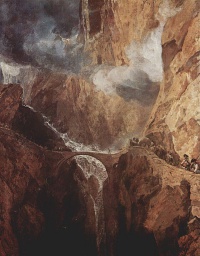Devil
From The Art and Popular Culture Encyclopedia
| Revision as of 20:53, 28 May 2007 WikiSysop (Talk | contribs) ← Previous diff |
Current revision Jahsonic (Talk | contribs) |
||
| Line 1: | Line 1: | ||
| + | {| class="toccolours" style="float: left; margin-left: 1em; margin-right: 2em; font-size: 85%; background:#c6dbf7; color:black; width:30em; max-width: 40%;" cellspacing="5" | ||
| + | | style="text-align: left;" | | ||
| + | "The devil's finest trick is to persuade you that he does not exist."[[La plus belle des ruses du Diable est de vous persuader qu'il n'existe pas!|[...]]] --Charles Baudelaire | ||
| + | <hr> | ||
| + | "The [[Devil]] is part of our experience. Our generation has seen enough of it for the message to be taken extremely seriously. [[Evil]], I contend, is not contingent, it not the [[absence of good|absence, or deformation, or the subversion of virtue]] (or whatever else we may think of as its opposite), but a stubborn and unredeemable fact"--[[Leszek Kołakowski]] | ||
| + | |} | ||
| + | [[Image:The Devil's Bridge.jpg|thumb|200px|''[[The Devil's Bridge, St. Gotthard]]'' (1803-1804) by J. M. W. Turner]] | ||
| + | |||
| {{Template}} | {{Template}} | ||
| - | [http://en.wikipedia.org/wiki/{{PAGENAMEE}}] [May 2007] | + | The '''Devil''' is a title given to the [[supernatural]] entity, who, in [[Christianity]], [[Islam]], and other religions, is a powerful, [[evil]] entity and the tempter of humankind. In conservative Christianity, God and the Devil are usually portrayed as fighting over the souls of humans, with the Devil seeking to lure people away from God and into hell. The Devil commands a force of lesser evil spirits, commonly known as [[demons]]. |
| - | [[Devil's Trill sonata]] | + | |
| + | The Devil is commonly associated with [[heretic]]s, [[infidel]]s, and other [[unbeliever]]s. The [[Hebrew Bible]] (or Old Testament) does not assign this level of personification to a devil, but rather identifies all good and evil as originating in the will of God. In [[humour]], concept of something as evil as Satan is often mocked. | ||
| + | |||
| + | This entity is commonly referred to by a variety of names, including [[Angra Mainyu]], [[Satan]], [[Asmodai]], [[Beelzebub]], [[Lucifer]], [[Belial]], or [[Iblis]]. Many other religions have a trickster or tempter figure that is similar to the Devil. Modern conceptions of the Devil include the concept that it symbolizes humans' own lower nature or sinfulness. | ||
| + | |||
| + | ==In painting== | ||
| + | *[[Michael Pacher]]'s panel painting ''[[The Devil Presenting St Augustine With The Book Of Vices]]'' | ||
| + | |||
| + | |||
| + | == Namesakes == | ||
| + | *''[[The Devil's Dictionary]]'' by Ambrose Bierce | ||
| + | *[[Devil's Trill sonata]] by Giuseppe Tartini | ||
| + | == See also == | ||
| + | *[[Devil in popular culture]] | ||
| + | *[[The devil in fiction]] | ||
| + | *[[Devil's music]] | ||
| + | *[[Devil worship]] | ||
| + | *[[Diablerie]] | ||
| + | *[[Faust]] | ||
| + | *[[Hierarchy of devils]] | ||
| + | *[[Names of the demons]] | ||
| + | *[[Hell]], [[Hades]], [[Underworld]] | ||
| + | *[[Lawsuits against the Devil]] | ||
| + | *[[Number of the Beast]] | ||
| + | *[[Deal with the Devil]] | ||
| + | *[[Satanism]] | ||
| + | |||
| + | {{GFDL}} | ||
Current revision
|
"The devil's finest trick is to persuade you that he does not exist."[...] --Charles Baudelaire "The Devil is part of our experience. Our generation has seen enough of it for the message to be taken extremely seriously. Evil, I contend, is not contingent, it not the absence, or deformation, or the subversion of virtue (or whatever else we may think of as its opposite), but a stubborn and unredeemable fact"--Leszek Kołakowski |

|
Related e |
|
Featured: |
The Devil is a title given to the supernatural entity, who, in Christianity, Islam, and other religions, is a powerful, evil entity and the tempter of humankind. In conservative Christianity, God and the Devil are usually portrayed as fighting over the souls of humans, with the Devil seeking to lure people away from God and into hell. The Devil commands a force of lesser evil spirits, commonly known as demons.
The Devil is commonly associated with heretics, infidels, and other unbelievers. The Hebrew Bible (or Old Testament) does not assign this level of personification to a devil, but rather identifies all good and evil as originating in the will of God. In humour, concept of something as evil as Satan is often mocked.
This entity is commonly referred to by a variety of names, including Angra Mainyu, Satan, Asmodai, Beelzebub, Lucifer, Belial, or Iblis. Many other religions have a trickster or tempter figure that is similar to the Devil. Modern conceptions of the Devil include the concept that it symbolizes humans' own lower nature or sinfulness.
In painting
- Michael Pacher's panel painting The Devil Presenting St Augustine With The Book Of Vices
Namesakes
- The Devil's Dictionary by Ambrose Bierce
- Devil's Trill sonata by Giuseppe Tartini
See also
- Devil in popular culture
- The devil in fiction
- Devil's music
- Devil worship
- Diablerie
- Faust
- Hierarchy of devils
- Names of the demons
- Hell, Hades, Underworld
- Lawsuits against the Devil
- Number of the Beast
- Deal with the Devil
- Satanism

